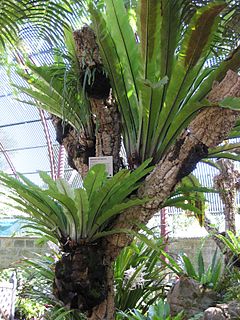- Asplenium australasicum
-
Asplenium australasicum 
Scientific classification Kingdom: Plantae Division: Pteridophyta Class: Pteridopsida Order: Polypodiales (unranked): Eupolypods II Family: Aspleniaceae Genus: Asplenium Species: A. australasicum Binomial name Asplenium australasicum
(J.Sm.) Hook.Asplenium australasicum is a species of plant in the Aspleniaceae family found in eastern Australia.
Contents
Taxonomy
Asplenium australasicum was originally described by English botanist John Smith in 1857 as Neottopteris australasica.[1] He had reclassified the already known A. nidus in its own genus Neottopteris. Other botanists reclassified the genus as a section, Thamnopteris, within the genus Asplenium,[2] and William Jackson Hooker gave it its current binomial name in 1859.[3] Although the section Thamnopteris is distinctive, defining the species has been difficult as the morphology of the plants is so simple.[2] A. australasicum has been confused with (and called) A. nidus,[4] and Japanese populations which were considered to be A. australasicum by their morphology have been found to be genetically distinct and reclassified as a new species, A. setori.[2]
Common names include bird's nest fern and crow's nest fern.[5]
Description
Asplenium australasicum grows as shrubby plant, with a rosette of yellow-green fronds which are 60 to 80 cm (24-32 in) long and 3 to 21 cm (1.2-8.4 in) wide.[6] It can be distinguished from A. nidus by its prominent midrib under its fronds, giving the fronds a keeled shape.[2] The spores form in parallel lines which run in parallel with the veins and oblique to the midrib.[4]
Distribution and habitat
Found in New South Wales and Queensland, it grows on rocks or on trees and is found in eastern New South Wales and Queensland.[6] The clumps can reach a large size, with the centre of the fern acting as a reservoir for debris.[4]
Cultivation
Asplenium australasicum specimens were taken from logged areas, which helped them become popular in horticulture.[4] It adapts readily to cultivation, as long as it has good drainage. Poor drainage renders it vulnerable to rotting.[7] It can be grown in a tub or barrel.[5] In cultivation it is occasionally attacked by white coconut scale on the underside of the fronds.[5]
See also
- Flora of Tubuai
References
- ^ "Neottopteris australasica J.Sm.". Australian Plant Name Index (APNI), IBIS database. Centre for Plant Biodiversity Research, Australian Government. http://www.anbg.gov.au/cgi-bin/apni?taxon_id=25991.
- ^ a b c d Noriaki Murakami, Mikio Watanabe, Jun Yokoyama, Yoko Yatabe, Hisako Iwasaki and Shunsuke Serizawa (1999). Molecular Taxonomic Study and Revision of the Three Japanese Species of Asplenium sect. Thamnopteris. 112. pp. 15–25. doi:10.1007/PL00013856.
- ^ "Asplenium australasicum (J.Sm.) Hook.". Australian Plant Name Index (APNI), IBIS database. Centre for Plant Biodiversity Research, Australian Government. http://www.anbg.gov.au/cgi-bin/apni?taxon_id=51413.
- ^ a b c d Fairley, Alan; Moore, Philip (2000). Native Plants of the Sydney District:An Identification Guide (2nd ed.). Kenthurst, NSW: Kangaroo Press. p. 41. ISBN 0-7318-1031-7.
- ^ a b c Elliot, Rodger (2003). Australian Plants for Mediterranean Climate Gardens. Rosenberg Publishing. pp. 45. ISBN 1877058181. http://books.google.com.au/books?id=TJi4uzF31UQC&pg=PA45&dq=Asplenium+australasicum&hl=en&ei=9re7TuLXMIramAXQm-CiCA&sa=X&oi=book_result&ct=result&resnum=4&ved=0CEUQ6AEwAw#v=onepage&q=Asplenium%20australasicum&f=false.
- ^ a b New South Wales Flora Online: Asplenium australasicum by Peter G. Wilson, Royal Botanic Gardens & Domain Trust, Sydney, Australia
- ^ Walters, Brian (November 2007). "Asplenium australasicum". Australian Native Plants Society (Australia). http://anpsa.org.au/a-aust.html. Retrieved 10 November 2011.
- DR Drake, WA Whistler, TJ Motley, CT Imada, (1996). Rain forest vegetation of'Eua Island, Kingdom of Tonga, New Zealand journal of botany.
Categories:- Asplenium
- Fern species
- Pteridophyta of Australia
- Flora of New South Wales
- Flora of Queensland
- Plants described in 1857
Wikimedia Foundation. 2010.
